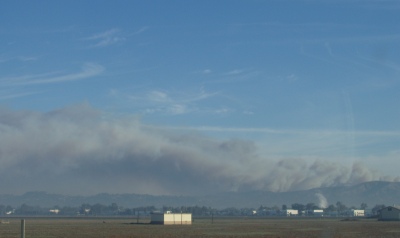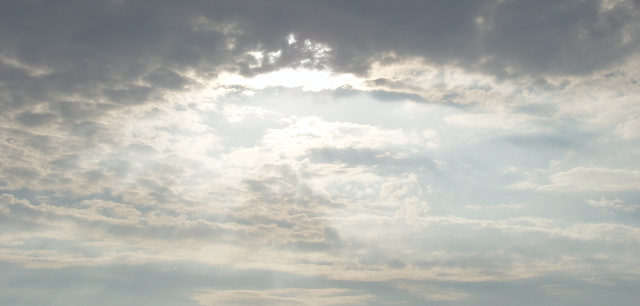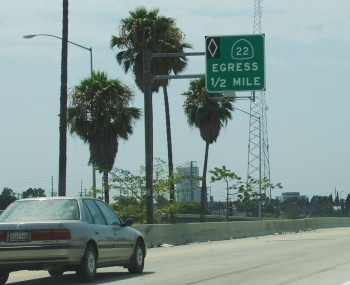They say that the Southern California car culture is isolating. It’s hard to argue with that, when everyone’s shut up in their own little boxes. But today, on my way to work (delayed a bit on account of dentist), I was listening to KCRW’s Morning Becomes Eclectic and stopped at a traffic signal. They were playing a live version of Elvis Costello’s “Allison.” I looked in my rear view mirror, and realized that the driver behind me was singing along to the same song. Even though it only went one way—she had no way of knowing I was listening to the same music—it was still a moment of connection through shared experience.
Tag: SoCal
Pick a city, please!
A few days ago I was remarking on the signs by the side of the 405 indicating where to find the Cal State Fullerton El Toro Campus. This is odd for several reasons, namely:
- The signs went up years after the city of El Toro changed its name to Lake Forest.
- Having the two cities in the name makes it sound like “University of California, Colorado Campus.”
- From what I could tell, it wasn’t even in El Toro/Lake Forest—it was in Irvine.
Today I noticed that the signs have been changed to read “Cal State Fullerton, Irvine Campus.” That takes care of 2 out of 3, and the remaining one is at least logical, even if it sounds a bit odd. I mean, it’s a satellite campus, what else are you going to call it aside from the school name plus the location?
As for why they started out calling it the El Toro campus: it turns out it’s on the grounds of the former El Toro Marine Base.
Smoke and Fog
Monday morning dawned foggy. By the time we left for work, most of the fog had burned off, but we looked out the car window and saw a huge, billowing gray cloud hugging close to the ground. If this had been the usual fire season, or if there had been no fog to start with (or if there had been time for coffee to take effect), I think we would’ve both immediately recognized it as smoke from a brush fire. The Sierra fire in the Cleveland National Forest had started just a few hours earlier.

There was still fog around, though. Continue reading
Cloud Cover-Up
Today was a reminder that just having cloud cover doesn’t necessarily keep things cool. We’ve had occasional wispy clouds at evening, and at one point some serious cloud cover closer to the coast, but today was hazy and overcast all day—and it was just plain muggy.

Eh, it’s only early August. It’ll get hotter (and occasionally muggier).
Clouds on the Horizon
Well, June Gloom seems to be over, and we’re now into the time of year when we get hot, sunny days with lots of clouds. Big, towering cumulus clouds, often with anvil heads, promising shade and rain to cool things down. The teases.
Yeah, we see those clouds most afternoons—on the horizon, just on the other side of the coastal mountains!
While it’s great for summer activities—beach trips, swimming, hiking, etc.—it can also be frustrating when you have to choose between running your electricity-guzzling air conditioner all day or leaving your window open all night. The clouds are right there, taunting you with relief from the heat—relief that will not come.

When I was in high school, my family took a vacation across the Great American SouthwestTM. We went to Bryce Canyon, Zion Canyon, and the Grand Canyon. We drove out to Mesa Verde, which wasn’t a canyon, but there were still a lot of cliffs. We came back through Arizona, where we stopped by Meteor Crater and Sunset Crater. We joked that it was a tour of all the big holes in the ground. (A few years later, I posted some photos from this trip online.)
The weird thing about it was that we went during August, and we got rained on at least briefly almost every afternoon—but only outside of California. Utah? Rain. Arizona? Rain. Colorado? Rain. I don’t think we got rained on during our three hours in Nevada (we stopped at Valley of Fire on the way out), but as I recall, the rain stopped about the time we crossed from Arizona back into California.
We don’t get summer storms much here in SoCal.
This Way to the Egress
Whenever I see this sign, I always think of the story about P.T. Barnum trying to get his visitors out of an exhibit so that new customers could come in. He eventually put up a sign saying “This way to the egress,” figuring most people wouldn’t know the word just meant “exit.” According to the legend, it worked.

Now, given that every other freeway sign I’ve seen says “exit,” I have to wonder why they phrased this one the way they did. My best guess is that it’s because it’s marking an exit from the carpool lane (it’s on the Santa Ana Freeway, heading north between the 55 and 22) instead of an exit to surface streets or directly to another freeway—but even that doesn’t make sense, because every place where you’re allowed to leave a carpool lane is marked as “exit!”
Yes, it does rain in L.A.
An intense deluge woke us up briefly around 5:00 this morning. I think I was awake enough to say “Damn!” and fall back asleep. It reminded me of something that’s been bugging me.
I looked through the first few pages of Otherworld #2 in the comic store yesterday. As at the end of the first issue, one character made a big deal about how it never rains in L.A.
Admittedly, people drive as if it were true. It starts drizzling, and people freak out. Three days of rain is billed as Stormwatch 2005 on the TV news. Some years we don’t get much rain at all.
But every 7 or 8 years, we get drenched.
I’ve heard people cite this year’s near-record rainfall as an example of the extreme weather that climate models predict for global warming. While I do think there are plenty of valid examples, this isn’t one of them. We got just as much rain in 1997—eight years ago—when the UCI campus flooded, stairs turned into waterfalls, streets and underpasses became rivers, and one student infamously bodysurfed naked down the hill next to the Student Center. (A yearbook(?) ad later remarked, “Who says nothing happens in Irvine?”) We got nearly as much rain two years before that. I knew someone from Vermont who brought friends out to visit during the heaviest period of rain. They got their preconceptions handed to them.
Every once in a while the cycle skips. Those skips coincide suspiciously with droughts. I remember tons of rain and the occasional hailstorm in the early 1980s, then it was all dry until 1995.
The thing is, while a very wet winter is uncommon for Southern California, it’s not unusual. In fact, it’s very regular. I recommend looking up El Niño as a starting point.